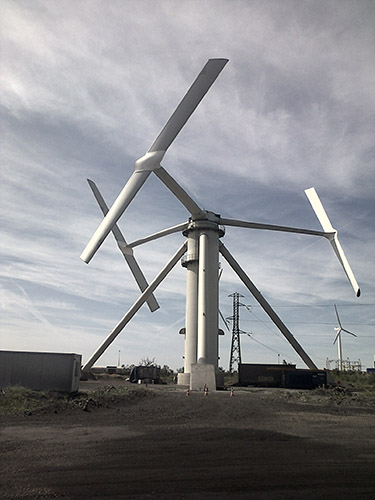
The onshore, full-size prototype has been operating at a test site near Marseilles since May, 2014, with only one level of a three-level blade system. The next stage will replace this prototype with one consisting of all three levels in 2015.
Leave it to clever French engineers to defy convention. Just scan the photos of offshore turbines going up in Europe and there is nary a floating two-blade or vertical-axis turbine in sight. But that will soon change thanks to the inventive minds at Nénuphar. In 2006, co-founders Charles Smadja and Frédéric Silvert launched the Vertiwind project, and in 2014, its first prototype was tested in southern France.
The 2-MW, floating, vertical-axis turbine is designed for offshore wind production in waters up to 200 m deep. Technip, who partnered with Nénuphar in 2009, designed the floating platform, mooring system and connection cable. The engineering and construction company is also responsible for the system’s on-site installation.
A limited number of vertical-axis turbines have been built and all feature curved-blades connecting to the main shaft at the top and bottom of the blade. However, Nénuphar is taking a different approach by using straight blades that connect to a central shaft by two struts near the bottom of the blade.
At 100m blade height, the relatively short turbine allows for a maximum tilt greater than that of its horizontal-axis counterparts, resulting in a lighter floater with the same annual electricity production rate. Optimal tilt reduces the “bending moment and increases torque (partly because the struts act like blades).
Another feature setting Vertiwind apart is the generator placement. A horizontal-axis turbine with the same height and output power would require placing the generator 60 m above sea level. Vertiwind’s design places a 50-ton, direct-drive permanent magnet generator inside a sealed tube beneath the blades only 20m above sea level. Nénuphar says customers will see investment and O&M costs reduced by 30% compared to current offshore turbines.
How is this possible? The generator’s placement gives the turbine a lower center of gravity, resulting in greater stability and fewer gyroscopic effects. Also, the design allows for a smaller, less expensive floating platform—extending only 9m below the ocean’s surface—and the entire unit can be assembled onshore at any harbor. Other benefits of Vertiwind include: no yaw, pitch or gearbox; no offshore craning (only tugboats are needed); a 50% lower failure rate than conventional horizontal-axis turbines; and, as a bonus, it’s Environmental Health and Safety friendly.
Filed Under: News, Offshore wind, Turbines





As you know, it’s necessary to reduce vibration to install a Floating Wind Turbine in the sea. Vibration causes many problems. Vibrations come from wind, waves, and external forces. However, a new Floating Body Stabilizer for Floating Wind Turbines has been designed in South Korea. The Floating Body Stabilizers generate drag force immediately when Floating Wind Turbines are being rolled and pitched on the water.
It’s important to maintain effectively same direction and position on the water for floating wind power plants. Similarly, directional changes to solar panels reduces electricity production. So floating wind power plants also need a directional control mooring systems for their parked positions. Azimuth and position change of floating solar plants are caused by wind, waves, and external forces.
A Restoring Force Strengthened Mooring System for floating solar plants has also been created in South Korea. This Mooring System generates Restoring Force immediately when floating solar plants are being rotated or moved on the water. You can see the Restoring Force Strengthened Mooring System and Floating Body Stabilizers in Ochang Dam, South Korea. I N IWORLD